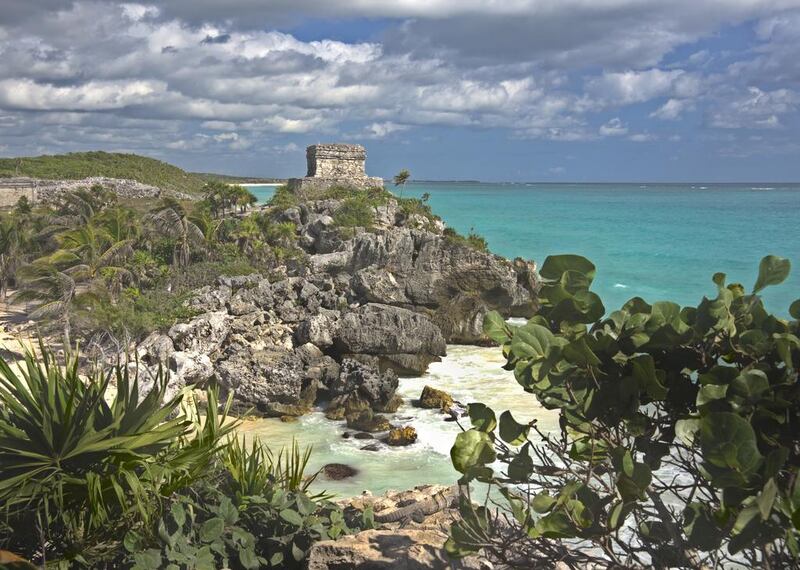Why Tulum?
Drive past Cancún and its overcrowded resorts, take a sharp turn before the modest town of Tulum and you’ll find yourself on a long, narrow road tucked between the jungle and the Caribbean.
This is Tulum Beach, known for its rustic elegance, peaceful atmosphere and bubbly nightlife. Its important Mayan ruins, raw landscapes and relaxed vibe attract a colourful crowd. Its endless beaches, where buttery sand shines against the turquoise ocean, were first favoured by hippies and New Agers decades ago. Indeed, yoga, shamans, massage centres and spiritual offerings make up Tulum’s bohemian charm, but it’s now equally prized by models, A-list actors and gallerists – it’s New Yorkers’ unofficial beach resort.
Tulum’s history is deep and rich. In 1200AD, the Maya set up a city and worship centre here, protected by a massive fortress, and sailed along its seas to trade goods and produce (Tulum is Maya for “wall”). The city was abandoned 75 years after the Spanish conquest. Now, it’s home to about 20,000 Maya and expats, who coexist peacefully, and mostly focuses on the tourism economy.
Exploring the stunning ruins and pristine cenotes amid the festive atmosphere makes for a fun, sun-soaked holiday just a four-hour flight from New York.
A comfortable bed
Far from the all-inclusive, massive resorts of Cancún, most hotels in Tulum offer rustic cabanas on the beach or in the jungle – stay on the beach for better views and fewer mosquitoes. Casa Violeta (www.casavioletatulum.com) is a romantic retreat with beautifully decorated rooms, an exquisite restaurant perched above the sand, a spa and yoga hut. Bungalows cost from US$200 (Dh735).
Coqui Coqui (www.coquicoquiperfumes.com) is a swankier option for those in search of luxury on the beach. Opened by two European models, it attracts the fashion elite and celebrities, and has a high-end ambience, as well as a beautiful spa. The hotel's homemade fragrances and beauty products, along with fine leather and cotton caftans, are sold at its boutique. Rooms cost from $250 (Dh918).
Find your feet
Start early when visiting the Mayan ruins of Tulum, as the crowds thicken around mid-morning. Reigning on 12-metre-tall cliffs on the ocean’s edge, the well-preserved ancient city illustrates the sophisticated economic, social and worship systems of the Maya.
After a steamy morning, the most delightful reward is a plunge in a fresh limpid cenote, where the Maya once communicated with the gods. Maya Blue, Naharon, Temple of Doom, Tortuga, Vacaha, Grand Cenote, Abejas, Nohoch Kiin and Carwash are all a short drive away from the ruins. There, you’ll find perfect peace, mineral-rich waters and lush vegetation.
Visit the Sian Ka’an natural reserve, where, alongside narrow windy canals, hundreds of rare flowers, trees and birds come together in an otherworldly symphony. Sunset on a canal boat is an unforgettable experience.
Meet the locals
Tulum attracts a diverse crowd of cosmopolitan, open-minded travellers. Conversations usually start at the beach and end at one of the festive nightspots in town. Gitano (www.gitanotulum.mx) is a bohemian jungle party spot where youngsters in Italian linen and printed designer dresses dance all night.
Book a table
The chef Eric Werner moved here from New York several years ago, lured by the area's rawness and spiritual energy. He set up a wood-fired oven in the middle of the jungle and added a bar and a few tables, illuminated only by oil lamps. Now crowds line up for several hours outside Hartwood (www.hartwoodtulum.com) for a meal of charred steak served with caramelised yams and greens. Other favourites include tender octopus and potatoes, whole roast fish and meaty beets – all cooked in the oven. Werner, a leader in the slow-food movement, goes into the jungle with a truck to forage his ingredients and runs the entire restaurant without electricity.
Another jungle-side local hit is El Tábano (www.eltabanorestaurant.com), opened by two charming Spaniards who hire Maya mothers and grandmothers to concoct traditional meals such as mole and pipian. The cooks grind spices and chillies for their elaborate sauces in the open kitchen. Try the fish in red spicy sauce ($15 [Dh55]), the camarone in mole ($18 [Dh66]) and the red chicken ($13 [Dh48]). The chairs and tables, colourfully customised by an artist who works at the restaurant, sit in the middle of the lush garden. The atmosphere is bubbly and laid-back – and it's the only place to get authentic home cooking in the area if you're not in the mood for pasta or sushi, which many of the touristy resorts offer.
Shopper’s paradise
Whether for beachwear or souvenirs, head to Josa Tulum (www.josatulum.com). Go to Mr Blackbird (www.mr-blackbird.com) for bright crochet bags and boho jewels.
What to avoid
The large resorts of Tulum, where you will miss out on the true charms of this quaint, bohemian town.
Don’t miss
Go to the pueblo, or town, where you will find juice carts, fresh coconuts, meat tacos and kitsch souvenirs at friendly prices.
Getting there
American Airlines in cooperation with Etihad (www.etihad.com) flies from Abu Dhabi to Cancún via New York for Dh5,000 return, including taxes.
weekend@thenational.ae
Follow us @TravelNational
Follow us on Facebook for discussions, entertainment, reviews, wellness and news.





